#sanjuansaurus
Explore tagged Tumblr posts
Text
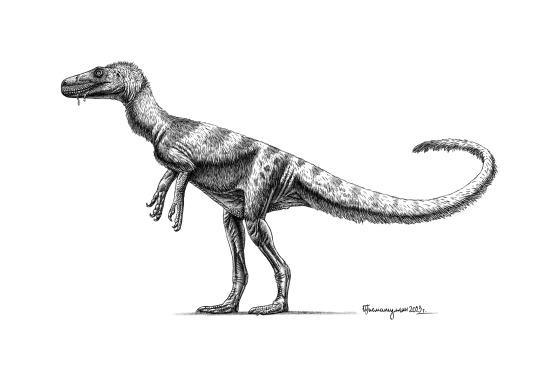
Reconstruction of the early dinosaur Herrerasaurus ischigualastensis from the Late Triassic (Carnian stage) Argentina. This genus was described by Osvaldo Reig back in 1963, but due to the fragmentary nature of the bones, the classification of the animal was controversial (opinions were expressed that it was a prosauropod or even a dinosaur outside the two main groups). Only in 1988 was a complete skeleton with a skull found, which allowed reconstructing the dinosaur and its approximate kinship. However, it is still unclear whether Herrerasaurus was an early theropod or whether it was closer to sauropodomorphs. The remains, named Ischisaurus cattoi and Frenguellisaurus ischigualastensis, were later assigned to Herrerasaurus.
Herrerasaurus is interesting for its rather large size for an early predatory dinosaur: some specimens of "Frenguellisaurus" reached 6 m. The skull was relatively small, but the jaws carried sharp saw-toothed teeth, including "fangs". There was also a shock-absorbing joint in the middle of the jaw, which allowed holding large prey. The hands were armed with three grasping fingers, and the longest of them was the third. The rudimentary fourth and fifth fingers were hidden by soft tissues. The pelvis of a Herrerasaurus is unusual. Only two sacral vertebrae fused with it (at least 3 in other dinosaurs), and the acetabulum was not completely open. At the same time, the pubic bone was directed not forward, but backward, as in maniraptorans, and carried a massive "boot". At one time, this served as the basis for Gregory Paul to designate the herrerasaurs as an early group in which bird-like features arose, and even to bring them closer to the "protoavis".
In this work, I tried out a style with shading using a black pencil, not a pen. It is much easier to apply shadows with a pencil, and I liked the result. It shows an extensive cover of filaments inspired by a possible "fluffy" ancestral state for ornithodirans (dinosaurs, pterosaurs and small groups close to them).
Black ballpoint pen and black colored pencils, 2023.
#herrerasaurus ischigualastensis#herrerasaurus#frenguellisaurus#ischisaurus#sanjuansaurus#staurikosaurus#herrerasauridae#saurischia#early dinosaurs#late triassic fauna#paleoart
28 notes
·
View notes
Text
Archovember 2024 Day 24 - Sillosuchus longicervix

As we know by now, pseudosuchians ruled the earth during the Triassic period, slotting into many different niches and utilizing many different body shapes than just the semi-aquatic crocodilians we have today. Poposauroids especially filled many of the niches dinosaurs would later come to fill, and even resembled them. Our previously visited Lotosaurus was convergent with hadrosaurs and stegosaurs. Poposaurus was convergent with theropod carnivores. The shuvosaurids resembled ornithomimid theropods, and one shuvosaurid in particular: Sillosuchus longicervix, reached sizes that would make the early sauropodomorphs tremble.

Sillosuchus lived in Late Triassic Argentina. The holotype, while still quite large for a shuvosaurid, was about 3 m (9.8 ft) long. But then, a finding of a large Sillosuchus-like neck vertebrae, as well as fragments of the tibia and ankle, pushed this animal’s size estimates up to 9 to 10 m (30 to 33 ft) in length, making it the tallest terrestrial pseudosuchian known. It would have had a beak like its relatives Effigia and Shuvosaurus, and likely used it to shear off plant material, reaching higher into the trees than any pseudosuchian would have ever hoped to dream. And since Sillosuchus came first, this makes sauropods the copy-cats!

Sillosuchus was found in the Cancha de Bocha member of the Ischigualasto Formation, which was at the time characterized by a dry climate with meandering rivers and seasonal rainfall. Sillosuchus would have lived alongside other dinosaur-like pseudosuchians, including the armoured Aetosauroides, the small, agile Trialestes, and the apex predator Saurosuchus. Dinosaurs would have included the early sauropodomorphs Chromogisaurus, Panphagia, and Eoraptor, and the early theropods Eodromaeus, Sanjuansaurus, and Herrerasaurus. Other reptiles would have included the silesaur Ignotosaurusm, the mysterious Incertovenator, the crocodile-like Proterochampsa and Pseudochampsa, the bizarre rhyncosaur Hyperodapedon, and the lepidosauromorph Taytalura. Synapsids like cynodonts and dicynodonts were also common here, and temnospondyls lived within the meandering rivers.

This art may be used for educational purposes, with credit, but please contact me first for permission before using my art. I would like to know where and how it is being used. If you don’t have something to add that was not already addressed in this caption, please do not repost this art. Thank you!
#Sillosuchus longicervix#Sillosuchus#poposaur#poposaurids#pseudosuchians#archosaurs#archosauromorphs#reptiles#Archovember#Archovember2024#Dinovember#Dinovember2024#SaritaDrawsPalaeo#Late Triassic#Argentina#Ischigualasto Formation
24 notes
·
View notes
Photo

Here’s the finished product from yesterday! Saurosuchus isn’t ready to hand off the title of apex predator to the dinosaurs yet, and devours a Sanjuansaurus
#Saurosuchus#Sanjuansaurus#dinosaurs#paleoblr#palaeoblr#paleoart#art#drawing#traditional art#pen#pencil#rauisuchia#rauisuchian#crurotarsi#Triassic#Argentina#carnian#ischigualasto#paleo
170 notes
·
View notes
Photo

9/20/22 Sanjuansaurus
146 notes
·
View notes
Text
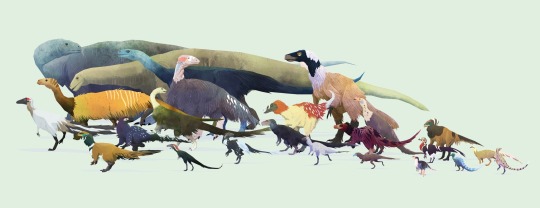
And now, time for an all dinosaurian Triassic fauna. From left to right: Coelophysis bauri, Blikanasaurus cromptoni, Ingentia prima, Lessemsaurus sauropoides, Unaysaurus tolentinoi, Chindesaurus bryansmalli, Efraasia minor, Coloradisaurus brevis, Camposaurus arizonensis, Eucnemesaurus fortis, Guaibasaurus candelariensis, Gnathovorax cabreirai, Sanjuansaurus gordilloi, Pampadromaeus barberenai, Herrerasaurus ischigualastensis, Staurikosaurus pricei, Eodromaeus murphi, Bagualosaurus agudoensis, Alwalkeria maleriensis, Panphagia protos, Chromogisaurus novasi, Eoraptor lunensis, Saturnalia tupiniquim and Buriolestes schultzi.
#palaeoblr#palaeontology#paleontology#paleoart#illustration#dinosaur#triassic#palaeoart#animals#mesozoic#dinosauria#dinosaurs
132 notes
·
View notes
Photo

Sanjuansaurus
5 notes
·
View notes
Text
Pisanosaurus mertii
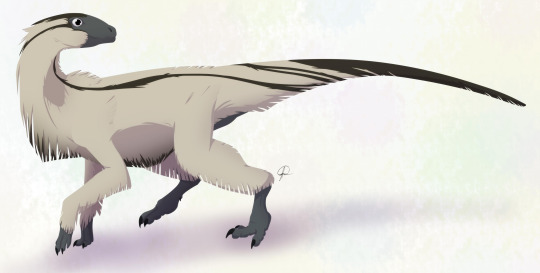
By José Carlos Cortés
Etymology: Pisano’s Reptile
First Described By: Casamiquela, 1967
Classification: Dinosauromorpha, Dinosauriformes, Dracohors, Silesauridae?
Status: Extinct
Time and Place: 231.4 million years ago, in the Carnian of the Late Triassic

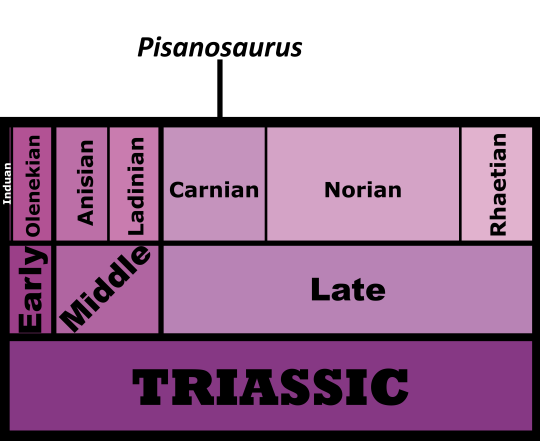
Pisanosaurus is known from the Cancha de Bochas Member of the Ischigualasto Formation in San Juan Argentina.
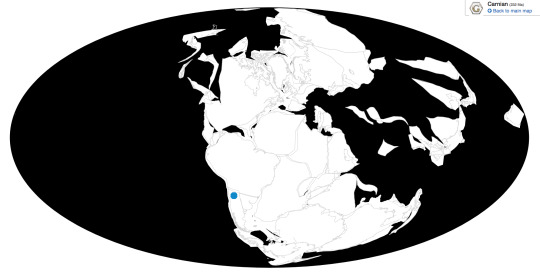
Physical Description: If a Silesaurid - as is currently thought - Pisanosaurus would have been a small, slender, and quadrupedal animal, only about 1 meter in length. It had an open hip socket, like dinosaurs, which may point to a very interesting phylogenetic position (see the Other section below). It had very elongated bones in its hands, and its upper hips were weirdly wide as well. Beyond that, we don’t know much about with Pisanosaurus may have looked like. It seems logical to suppose it would have had a small head with a little beak in the front of the mouth - as both Silesaurids and early Ornithischians (the other hypothesis for the type of creature Pisanosaurus was) have such structures for snipping off plant material. Given its small size, Pisanosaurus - like all other early members of the group of reptiles that would later include birds (Avemetatarsalia) - would have been covered with fluff all over its body. If Pisanosaurus was an early Ornithischian and not a Silesaurid, it would have been bipedal, with short forelimbs not used in locomotion.
Diet: Either way, Pisanosaurus would have been an herbivore, eating low-lying vegetation in its densely forested home.
Behavior: As a small, lithe herbivore, Pisanosaurus would have been very skittish - running at the slightest sign of danger, making sure to avoid the many large predators it shared a home with. It probably wouldn’t have been very social - given it wasn’t very abundant! - but it may have foraged in large groups of mixed herbivores, sticking together to rely on each other in the event of danger. This reliance would have allowed bulkier herbivores to notice and react to danger quicker (since the small lithe ones like Pisanosaurus would have already been running away) - and the smaller ones would have had large, bulky roadblocks to stop the approach of predators. As an early dinosaur, it most likely partook in some sort of care of its young, though of course, we do not know what.

(As an Ornithischian) by Michael B. H., CC BY-SA 3.0
Ecosystem: The Ischigualasto Environment is one of the more famous ecosystems of the Late Triassic - due to it being a hotbed of early dinosaur discoveries, including some of the earliest potential members of the group. In fact, it is such an important environment that today the rock formation is considered a UNESCO World Heritage Site. It was an extensive series of rivers channeling through a large floodplain, erring towards the wetter side of the scale - mud was the name of the game, and there was a wide variety of plant material present, including a dense conifer forest, ferns, and horsetails. It did experience seasonal rainfall, with possible times of extremely heavy precipitation. Occasionally, everything would be buried in volcanic ash - leading to the beautiful preservation of the environment.
Pisanosaurus wasn’t the only Silesaurid here - there was also Ignotosaurus, the slender and small Silesaurid. There were also famous early dinosaurs such as Eoraptor - the small, bipedal early Saurischian(?), Herrerasaurus and Sanjuansaurus, the large taxonomically-confusing predators, and Chromogisaurus, one of the earliest known “prosauropods.” Of course, this being the Triassic, dinosaurs were only a small part of the ecosystem. The Ischigualasto - like most places of the time period - was absolutely lousy with other archosauriformes! Non-Dinosaurian Archosauriformes were extensively diverse at this time, making up a large chunk of the “large charismatic land animal” roles. There was Aetosauroides, an Aetosaur (sort of like a cross between an ankylosaur, an ant-eater, and a crocodile), Proterochampsa and Pseudochampsa - crocodilian-like creatures that were actually equally closely related to crocodiles and dinosaurs - both frequented the rivers of the environment. Saurosuchus, a large and bulky stem-croc, would have been a huge pain in the rear for herbivores like Pisanosaurus. Sillosuchus was a weird stem-croc, bipedal and strangely dinosaur like - with even, potentially, a beak - but utterly scaly, and bulky in stature! There was also Venaticosuchus, an Ornithosuchid (one of the most basal groups of stem-crocs), and Trialestes - a fast moving stem-croc, and one of the earliest Crocodylomorphs (the group of crocodilians and their closest relatives).

(Without Feathers) by Nobu Tamura, CC BY-SA 4.0
It being the Triassic, this wasn’t an environment free of non-reptiles! Temnospondyls - large carnivorous amphibians - were crawling about; as were a variety of Synapsids. Small, carnivorous dog-shaped cynodonts like Chiniquodon would have directly competed with the local dinosaurs; they even grew to be quite large and fast, like in Diegocanis and Ecteninion. They also came in large, bulky herbivorous forms, like Exaeretodon. Dicynodonts were present too, with their strange pig-like appearance: Ischigualastia was a common synapsid on the floodplains of Pisanosaurus’ home. In short, Pisanosaurus was surrounded with a cast of characters showcasing some - but certainly not all - of the weirdness that the Triassic had to offer.
Other: What Is Pisanosaurus? Back in the day, Pisanosaurus was a famous creature for being one of the earliest “Ornithischian” dinosaurs - one of two major groups of dinosaurs, famous for including such later iconic members as Stegosaurus and Triceratops. In fact, for the longest time, Pisanosaurus was… the only Ornithischian known from the Triassic. This is odd, to say the least - there are dozens of Triassic dinosaurs known, they’re just all from the other group, the Saurischians (containing such iconic later forms as Apatosaurus, Tyrannosaurus, and… all birds). So, for the longest time, Pisanosaurus stood as a focal point of dinosaur research - an important piece of the puzzle of the origin of this elusive, but important group.
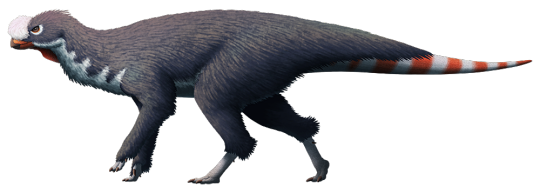
By Nix
Except it isn’t an Ornithischian. Lately, studies have shown time and time again that Pisanosaurus actually more closely resembles the Silesaurids - a group of almost dinosaurs that were quadrupedal, active herbivores living around the world at the time of the Triassic, before going extinct at the end-Triassic extinction. This would make its appearance much different than what a “basal Ornithischian” would suggest - and, of course, the fact that Pisanosaurus is known from only a single fragmented skeleton does not make solving this problem much easier. Weirdly enough, there are some hypotheses which suggest that Silesaurids are… the earliest Ornithischians, (as per Pisanosaurus having an open hip-socket), representing a weird side-branch of the group from the Triassic. As this hypothesis gains traction, it may become increasingly true that Pisanosaurus was a Silesaurid - it was just also an early Ornithischian. Only time will tell in the solving of this mystery - for now, we must wait for more evidence.
~ By Meig Dickson
Sources Under the Cut
Abdala, F. 2000. Catalogue of non-mammalian cynodonts in the Vertebrate Paleontology Collection of the Instituto Miguel Lillo, Universidad Nacional de Tucuman, with comments on species. Ameghiniana 37(4):463-475
Aceituno Cieri, P.; M.E. Zeballos; R.J. Rocca; R.D. Martino, and C. Carignano. 2015. Condicionantes geológicos en el cruce de la sierra de Valle Fértil. San Juan - Geological constraints at the crossing of sierra Valle Fertil. San Juan. Revista de Geología Aplicada a la Ingeniería y al Ambiente 35. 57–69.
Agnolin, F. L., (2015). "Nuevas observaciones sobre Pisanosaurus mertii Casamiquela, 1967 (Dinosauriformes) y sus implicancias taxonómicas". XXIX Jornadas Argentinas de Paleontología de Vertebrados. 27–29 de Mayo de 2015. Diamante, Entre Ríos. Libro de Resúmenes: 13–14.
Agnolín, Federico L.; Rozadilla, Sebastián (2017). "Phylogenetic reassessment of Pisanosaurus mertii Casamiquela, 1967, a basal dinosauriform from the Late Triassic of Argentina". Journal of Systematic Palaeontology. 16 (10): 853–879.
Alcober, Oscar A., and Ricardo N. Martínez. 2010. A new herrerasaurid (Dinosauria, Saurischia) from the Upper Triassic Ischigualasto Formation of northwestern Argentina. ZooKeys 63. 55–81.
Alcober, Oscar A., and J. Parrish. 2010. A new poposaurid from the Upper Triassic of Argentina. Journal of Vertebrate Paleontology 17. 548–556.
Anderson, J. M., and A. R. I. Cruickshank. 1978. The biostratigraphy of the Permian and the Triassic. Part 5. A review of the classification and distribution of Permo-Triassic tetrapods. Palaeontologica Africana 21:15-44.
Balabusic, Ana M., et al. 2001. Plan de Manejo del Parque Nacional Talampaya, 1–68. Administración de Parques Nacionales.
Bakker, R. T., and P. M. Galton. 1974. Dinosaur monophyly and a new class of vertebrates. Nature 248:168-172.
Bonaparte, J. F. 1969. Comments on early saurischians. Zoological Journal of the Linnean Society 48:471-480.
Bonaparte, J.F. (1970). "Annotated list of the South American Triassic tetrapods". Gondwana Symposium Proceedings and Papers. 2: 665–682.
Bonaparte, J. F. 1973. Edades reptil para el Triásico de Argentina y Brasil [Reptila ages for the Triassic of Argentina and Brazil]. Quinto Congreso Geológico Argentino, Ciudad de Villa Carlos Paz. Actas 3:93-129.
Bonaparte, J. F. 1976. "Pisanosaurus mertii Casamiquela and the origin of the Ornithischia". Journal of Paleontology 50(5): 808-820
Bonaparte, J. F. 1978. El Mesozoico de America de Sur y sus Tetrapodos [The Mesozoic of South America and its tetrapods]. Opera Lilloana 26:1-596.
Bonaparte, J. F. 1984. I dinosauri dell’Argentina [. In G. M. Ronzoni, M. L. Greggio, & T. B. Guarinoni (eds.), Sulle Orme dei Dinosauri 125-143.
Butler, R. J., R. M. H. Smith, and D. B. Norman. 2007. A primitive ornithischian dinosaur from the Late Triassic of South Africa, and the early evolution and diversification of Ornithischia. Proceedings of the Royal Society of London B 274:2041-2046.
Butler, Richard J.; Upchurch, Paul and Norman; David, B. (2008). "The phylogeny of the ornithischian dinosaurs". Journal of Systematic Palaeontology. 6 (1): 1–40.
Cabrera, Ángel. 1943. El primer hallazgo de terápsidos en la Argentina. Notas del Museo de la Plata 8. 317–331.
Cabreira, Sergio F.; Cesar L. Schultz; Jonathas S. Bittencourt; Marina B. Soares; Daniel C. Fortier; Lúcio R. Silva, and Max C. Langer. 2011. New stem-sauropodomorph (Dinosauria, Saurischia) from the Triassic of Brazil. Naturwissenschaften 98. 1035–1040.
Carroll, R. L. 1988. Vertebrate Paleontology and Evolution 1-698.
Casamiquela, R. M. 1967. Un nuevo dinosaurio ornitisquio triasico (Pisanosaurus mertii; Ornithopoda) de la Formación Ischigualasto, Argentina [A new Triassic ornithischian dinosaur (Pisanosaurus mertii; Ornithopoda) from the Ischigualasto Formation, Argentina]. Ameghiniana 4(2):47-64.
Colbert, E. H. 1981. A primitive ornithischian dinosaur from the Kayenta Formation of Arizona. Museum of Northern Arizona Bulletin 53:1-61.
Columbi, Carina E. (2008-10-05). Stable isotope analysis of fossil plants from the Upper Triassic Ischigualasto Formation in the northwest of Argentina. Houston, TX: The Geological Society of America.
Contreras, V. H. 1981. Datos preliminares sobre un nuevo rincosaurio (Reptilia, Rhynchosauria) del Triasico Superior de Argentina. Anais II Congresso Latino-Americano Paleontologia, Porto Alegre 2:289-294
Cox, C. B. 1965. New Triassic dicynodonts from South America, their origins and relationships. Philosophical Transactions of the Royal Society of London, Series B 248(753):457-516
Ezcurra, Martín D. 2010. A new early dinosaur (Saurischia: Sauropodomorpha) from the Late Triassic of Argentina: a reassessment of dinosaur origin and phylogeny. Journal of Systematic Palaeontology 8. 371–425.
Ezcurra, M. D., R. N. Martínez. 2016. Dinosaur precursors and early dinosaurs from Argentina. Book: Historia Evolutiva y Paleobiogeografía de los Vertebrados de América del Sur, Publisher: Contribuciones del MACN, Editors: F. Agnolíin, GL Lio, F. Brissón Egli, NR Chimento, F. Novas, 97-107.
Godefroit, P., S. M. Sinitsa, D. Dhouailly, Y. L. Bolotsky, A. V. Sizov, M. E. McNamara, M. J. Benton and O. Spagna. 2014. A Jurassic ornithischian dinosaur from Siberia with both feathers and scales. Science 345(6):451-455
Hollocher, K.T.; O.A. Alcober; C.E. Colombi, and T.C. Hollocher. 2005. Carnivore coprolites from the Upper Triassic Ischigualasto Formation, Argentina: chemistry, mineralogy, and evidence for rapid initial mineralization. Palaios 20. 51–63.
Irmis, R.B.; Parker, W.G.; Nesbitt, S.J.; Liu, J. (2007). "Early ornithischian dinosaurs: the Triassic record". Historical Biology. 19: 3–22.
Irmis, R. B., and F. Knoll. 2008. New ornithischian dinosaur material from the Lower Jurassic Lufeng Formation of China. Neues Jahrbuch für Geologie und Paläontologie Abhandlungen 247(1):117-128
Langer, M. C., and M. J. Benton. 2006. Early dinosaurs: a phylogenetic study. Journal of Systematic Palaeontology 4(4):309-358
Langer, M. C., Ezurra, M. D., Bittencourt, J. S., and Novas, F. E., 2009. The origin and early evolution of dinosaurs: Biological Reviews, v. 84, p. 1-56
Langer, Max C.; Sterling J. Nesbitt; Jonathas S. Bittencourt, and Randall B. Irmis. 2013. Anatomy, phylogeny and palaeobiology of early archosaurs and their kin. Geological Society, London, Special Publications 379. 157–186.
Lecuona, A.; M.D. Ezcurra, and R.B. Irmis. 2016. Revision of the early crocodylomorph Trialestes romeri (Archosauria, Suchia) from the lower Upper Triassic Ischigualasto Formation of Argentina: one of the oldest-known crocodylomorphs. Papers in Palaeontology 2. 585–622.
Lovelace, D., S. Hartman, B. J. Linzmeier, W. P. Porter. 2018. Deep-Time Application of Linked Microclimate and Biophysical Models Constrain the Thermal Ecology of Two Late Triassic Dinosaurs (Coelophysis, Plateosaurus). Journal of Vertebrate Paleontology Abstract Book: 171.
Madzia, D., C. A. Boyd, and M. Mazuch. 2018. A basal ornithopod dinosaur from the Cenomanian of the Czech Republic. Journal of Systematic Palaeontology 16(11):967-979
Marsola, J. C. A., J. S. Bittencourt, R. J. Butler, A. S. Da Rosa, J. M. Sayão, M. C. Langer. 2019. A new dinosaur with theropod affinities from the Late Triassic Santa Maria Formation, South Brazil. Journal of Vertebrate Paleontology: e1531878.
Martínez, R.N., and C.A. Forster. 1996. The skull of Probelesodon sanjuanensis, sp. nov., from the Late Triassic Ischigualasto Formation of Argentina. Journal of Vertebrate Paleontology 16. 285–291.
Martínez, Ricardo N., and Oscar A. Alcober. 2009. A Basal Sauropodomorph (Dinosauria: Saurischia) from the Ischigualasto Formation (Triassic, Carnian) and the Early Evolution of Sauropodomorpha. PLoS ONE 4. 1–12.
Martínez, Ricardo N.; Paul C. Sereno; Oscar A. Alcober; Carina E. Colombi; Paul R. Renne; Isabel P. Montañez, and Brian S. Currie. 2011. A Basal Dinosaur from the Dawn of the Dinosaur Era in Southwestern Pangaea. Science 331. 206–210.
Martínez, Ricardo N.; Eliana Fernández, and Oscar A. Alcober. 2013. A new non-mammaliaform eucynodont from the Carnian-Norian Ischigualasto Formation, Northwestern Argentina. Revista Brasileira de Paleontologia 16. 61–76.
Martínez, Ricardo N.; Cecilia Apaldetti; Oscar A. Alcober; Carina E. Colombi; Paul C. Sereno; Eliana Fernández; Paula Santi Malnis; Gustavo A. Correa, and Diego Abelin. 2013. Vertebrate succession in the Ischigualasto Formation. Journal of Vertebrate Paleontology Memoir 12: Basal sauropodomorphs and the vertebrate fossil record of the Ischigualasto Formation (Late Triassic: Carnian-Norian) of Argentina. 10–30.
Monetta, A.; J. Baraldo; A. Cardinali; R. Weidmann, and M. Lanzilotti. 2000. Distribución y características del magmatismo intratriasico de Ischigualasto, San Juan, Argentina, 644–648. IX Congreso Geológico Chileno.
Müller, R. T., S. Dias-da-Silva. 2017. Taxon sample and character coding deeply impact unstable branches in phylogenetic trees of dinosaurs. Historical Biology 21 (8): 1-4.
Norman, D. B., L. M. Witmer, and D. B. Weishampel. 2004. Basal Ornithischia. In D. B. Weishampel, H. Osmolska, and P. Dodson (eds.), The Dinosauria (2nd edition). University of California Press, Berkeley 325-334
Novas, F. E. 1986. Un probable teropodo (Saurischia) de la Formacion Ischigualasto (Triasico Superior), San Juan, Argentina [A probable theropod (Saurischia) from the Ischigualasto Formation (Upper Triassic), San Juan, Argentina]. IV Congreso Argentino de Paleontologia y Bioestratigrafia 1:1-6
Reig, O. A. 1963. La presencia de dinosaurios saurisquios en los "Estratos de Ischigualasto" (Mesotriasico Superior) de las provincias de San Juan y La Rioja (República Argentina) [The presence of saurischian dinosaurs in the "Ischigualasto beds" (upper Middle Triassic) of San Juan and La Rioja Provinces (Argentine Republic)]. Ameghiniana 3(1):3-20
Rogers, R. R.; Swisher III, C.C.; Sereno, P.C.; Monetta, A.M.; Forster, C.A.; Martinez, R.N. (1993). "The Ischigualasto tetrapod assemblage (Late Triassic, Argentina) and 40Ar/39Ar dating of dinosaur origins". Science. 260 (5109): 794–797.
Schencman, Laura Jazmín; Carina Colombi; Paula Santi Malnis, and Carlos Oscar Limarino. 2015. Diagenesis and provenance of the Los Colorados formation (Norian), Ischigualasto- Villa Unión basin, Northwest of Argentina. Revista de la Asociación Geológica Argentina 72. 219–234.
Sereno, P.C. (1991). "Lesothosaurus, "fabrosaurids", and the early evolution of Ornithischia". Journal of Vertebrate Paleontology. 11 (2): 168–197.
Sereno, P.C.; Novas, F.E. (1992). "The complete skull and skeleton of an early dinosaur". Science. 258 (5085): 1137–1140.
Sereno, P. C. 1999. The evolution of dinosaurs. Science 284:2137-2147
Trotteyn, María J.; Ricardo N. Martínez, and Oscar A. Alcober. 2012. A new proterochampsid Chanaresuchus ischigualastensis (Diapsida, Archosauriformes) in the early Late Triassic Ischigualasto Formation, Argentina. Journal of Vertebrate Paleontology 32. 485–489.
Trotteyn, María Jimena, and Martín D. Ezcurra. 2014. Osteology of Pseudochampsa ischigualastensis gen. et comb. nov. (Archosauriformes: Proterochampsidae) from the Early Late Triassic Ischigualasto Formation of Northwestern Argentina. PLoS ONE 9. 1–37.
Tucker, Maurice E.; Benton, Michael J. (1982). "Triassic environments, climates, and reptile evolution". Palaeogeography, Palaeoclimatology, Palaeoecology. 40 (4): 361–379.
Wallace, Rachel Veronica Simon. 2018. A new close mammal relative and the origin and evolution of the mammalian central nervous system (PhD thesis), 1–224. The University of Texas at Austin.
Yang, Z., B. Jiang, M. E. McNamara, S. L. Kearns, M. Pittman, T. G. Kaye, P. J. Orr, X. Xu., M. J. Benton. 2018. Pterosaur integumentary structures with complex feather-like branching. Nature Ecology & Evolution 3: 24 - 30.
#Pisanosaurus#Pisanosaurus mertii#Dinosauromorph#Silesaurid#Prehistoric Life#Factifle#Palaeoblr#Dinosaur#Mesozoic Monday#Triassic#South America#Herbivore#Feathered Dinosaurs#paleontology#prehistory#dinosaurs#biology#a dinosaur a day#a-dinosaur-a-day#dinosaur of the day#dinosaur-of-the-day#science#nature#factfile
264 notes
·
View notes
Photo








More improved versions of older illustrations.. From top to bottom (left to right): Panphagia protos, Eoraptor lunensis, Guaibasaurus candelariensis, Eucnemesaurus fortis, Alwalkeria maleriensis, Sanjuansaurus gordilloi, Saturnalia tupiniquim and Unaysaurus tolentinoi.
For prints, check: https://www.stavrosillustration.se
187 notes
·
View notes
Photo

Sanjuansaurus gordilloi was an herrerasaurid dinosaur. It lived during the Late Triassic (Carnian) period in northwestern Argentina. It was a lightly built, bipedal carnivore, about 3 metres in length.
The Ischigualasto Formation in northwestern Argentina was a volcanically active floodplain covered by forests, with a warm and humid climate. It was subject to seasonal variations including strong rainfalls. Vegetation consisted of ferns, horsetails, and giant conifers, which formed highland forests along the banks of rivers.
This is a speculative restoration based on the likelihood that proto-feathers were present in basal dinosaurs, and perhaps even a more ancestral animal, in light of the pycnofibers of pterosaurs.
For prints, check: https://www.stavrosillustration.se
97 notes
·
View notes
Text
Ignotosaurus fragilis

By Jack Wood on @thewoodparable
PLEASE SUPPORT US ON PATREON. EACH and EVERY DONATION helps to keep this blog running! Any amount, even ONE DOLLAR is APPRECIATED! IF YOU ENJOY THIS CONTENT, please CONSIDER DONATING!
Name: Ignotosaurus fragilis
Name Meaning: Unknown Reptile
First Described: 2013
Described By: Martínez et al.
Classification: Avemetatarsalia, Ornithodira, Dinosauromorpha, Dinosauriformes, Silesauridae
Ignotosaurus is a Silesaurid from the Ischigualasto Formation of Argentina, living about 231.4 million years ago, in the Carnian age of the Late Triassic. It is known from part of the leg bone, which indicates it was a small Silesaurid. This difference in leg bone probably indicates that it differed from other Silesaurids mainly in its method or needs during locomotion. It was closely related to Eucoelophysis, Silesaurus, and Sacisaurus, making it a fairly derived member of the Silesaurid group. Ignotosaurus lived in a complex community with many other species of reptiles, including early dinosaurs and other Archosauromorphs, such as Scaphonyx, Herrerasaurus, Proterochampsa, Chanaresuchus, Saurosuchus, Sillosuchus, Trialestes, Aetosauroides, Panphagia, Eoraptor, Chromogisaurus, Eodromaeus, and Sanjuansaurus. However, compared to, say, Herrerasaurus and Scaphonyx, or really, many others in this formation, it was relatively rare - indicating it was not a very common component of this ecology.
Source:
Martínez, R. N.m C. Apaldetti, O. A. Alcober, C. E. Colombi, P. C. Sereno, E. Fernandez, P. S. Malnis, G. A. Correa, D. Abelin. 2013. Vertebrate succession in the Ischigualasto Formation. Journal of Vertebrate Paleontology 32 (sup1): 10-30.
Shout out goes to @jrockdino!
#ignotosaurus#ignotosaurus fragilis#silesaurid#dinosauriform#dinosauromorph#jrockdino#palaeoblr#dinosaur#paleontology#prehistory#prehistoric life#dinosaurs#biology#a dinosaur a day#a-dinosaur-a-day#dinosaur of the day#dinosaur-of-the-day#science#nature#factfile#Dìneasar#דינוזאור#डायनासोर#ديناصور#ডাইনোসর#risaeðla#ڈایناسور#deinosor#恐龍#恐龙
124 notes
·
View notes
Text
Sanjuansaurus gordilloi

Source: https://en.wikipedia.org/wiki/Sanjuansaurus
Name: Sanjuansaurus gordilloi
Name Meaning: Raul Gordillo's San Juan lizard
First Described: 2010
Described by: Alcober & Martinez
Classification: Dinosauria, Saurischia, Eusaurischia, Theropoda, Herrerasauridae
Sanjuansaurus is a recently discovered early basal theropod, determined to be in the Herrerasauridae family due to its similar structure to Herrerasaurus. It was discovered in the Ischigualasto Formation in Argentina, in the same formation that Herrerasuarus was found in. It was from the Carnian Stage of the Late Triassic, about 231.4 million years ago. It was an early theropod, living amongst the other dinosaurs described in this blog, still outsized and outnumbered by the archosaurs and other reptiles in the area. It was a similar shape to the other Herrerasaurids, suggesting that the body type was an important part of the local ecosystem in the area.
Sources:
http://www.prehistoric-wildlife.com/species/s/sanjuansaurus.html
http://en.wikipedia.org/wiki/Sanjuansaurus
#sanjuansaurus#sanjuansaurus gordilloi#dinosaur#dinosaurs#a dinosaur a day#a-dinosaur-a-day#prehistory#Prehistoric Life#paleontology#biology#science#dinosaur of the day#dinosaur-of-the-day#nature#factfile
67 notes
·
View notes